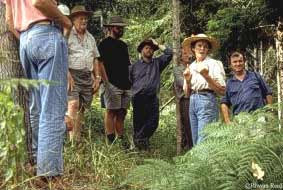|
|
|
Farmers’ design criteria

In many cases farmers can identify a range
of outcomes they want to achieve by establishing a farm forest.
Some will be essential to the forest’s success while
others will simply be desirable outcomes. The following considerations
will help farmers identify their individual priorities:
• Must haves—what the project must provide to satisfy
objectives.
• Like to have—extra benefits that would be welcome.
• Must nots—characteristics or outcomes that must
not occur.
• Prefer nots—characteristics or outcomes that should
be avoided.
These goals help highlight the design criteria that must be
achieved to satisfy farmers’ objectives, those that are
common to different objectives and those which might initially
appear contradictory. These goals form the basis for comparing
different farm forestry designs. A project plan is developed
when a farmer agrees to commit to a specific design.
Market research is an essential component of farm forest design
if the products or services produced by a forest are to be
sold. The farmer needs to find out about potential purchasers’
product specifications and marketing options that are available
for particular products and services.
Farmers’ personal performance measures are determined
by their aspirations and constraints. There are many ways
for farmers to assess the best option for their individual
circumstances even if they are only interested in the financial
return. Some might select options that maximise the return
per dollar invested. For others, the critical measure will
be the return per hectare or per hour of labour. The length
of the investment period might also be critical. Some farmers
will ignore investment options that take more than 20 or 25
years to mature, irrespective of the promised return.
Farmers consider several factors before deciding if they are
satisfied with an investment. They include the environmental,
financial and social benefits they can, or can expect to,
gain from the investment relative to their investment and
exposure to risk. A farmer might be prepared to consider multipurpose,
long-term timber production options when the costs or risks
are low, or there are non-commercial benefits. . On the other
hand they might reject the option of growing monoculture plantations
that provide few non-commercial benefits even if they promise
high returns.
Reviewing the role played by trees and forests in meeting
farmers’ goals and aspirations, can help identify and
set specific design principles.
Why plant trees?
Back to top
 |
|
|
|
